
If you use the existing technologies, time to send scientists and astronauts in an interstellar mission, you’ll need very, very much. The journey is painfully slow (even by space standards). If we want to make such a journey at least for one life, or a generation, we need a more radical (read: purely theoretical) measures. And if wormholes and subspace engines at the moment are absolutely fantastic, for many years there were other ideas in which we believe.
Nuclear power plant
Nuclear propulsion is a theoretically possible “engine” for rapid space travel. The concept was originally proposed by Stanislaw Ulam in 1946, the Polish-American mathematician who participated in the Manhattan project, and preliminary calculations were made by F. Reines and Ulam in 1947. Project “Orion” was launched in 1958 and lasted until 1963.
Under the leadership of Ted Taylor at General Atomics and physicist Freeman Dyson of the Institute for advanced study in Princeton, the Orion was supposed to use the power of pulsed nuclear explosions to provide a huge thrust with very high specific impulse.
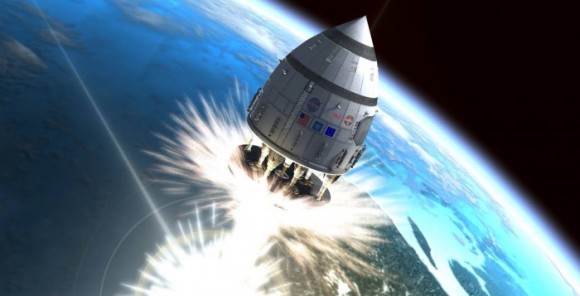
In a nutshell, project Orion includes a large spacecraft, which gains speed by supporting thermonuclear warheads, throwing bombs behind and accelerating through the blast wave, which goes at located rear “pusher”, the panel for push. After each push force of the explosion is absorbed by this panel and is converted into forward motion.
Although by modern standards this design hardly be called elegant, the advantage of this concept is that it provides high specific impulse — that is, remove the maximum amount of energy from a fuel source (in this case nuclear bombs) at minimum cost. In addition, this concept can theoretically overclock very high speed, according to some estimates, up to 5% of the speed of light (5.4 x 107 km/h).
Of course, this project had unavoidable downsides. On the one hand, a ship of this size would be extremely expensive to build. Estimated that have made Dyson in 1968, the spacecraft “Orion” on hydrogen bombs would weigh from 400 000 to 4 000 000 metric tons. And at least three-quarters of this weight will come from nuclear bombs, each weighing about one ton.
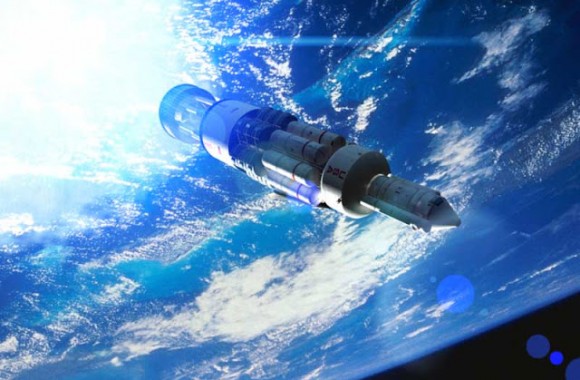
A modest estimate Dyson showed that the total cost of the construction of the “Orion” would have amounted to 367 billion dollars. Adjusted for inflation, that amount translates into 2.5 trillion dollars, quite a lot. Even under the most conservative estimates, the device will be extremely expensive to produce.
There is still a small problem of radiation that it will emit, not to mention nuclear waste. It is believed that for this reason the project was terminated under the Treaty on the partial test ban of 1963, when world governments have sought to limit nuclear testing and to stop the excessive release of radioactive fallout into the planet’s atmosphere.
Missiles on nuclear fusion
Another possibility of use of nuclear energy is nuclear fusion reactions to get traction. In the framework of this concept, the energy must be generated during the ignition of the granules of the mixture of deuterium and helium-3 in the reaction chamber of an inertial confinement using electron beams (similar to what you’re doing at the National ignition complex in California). Such a fusion reactor blowing up would be 250 pellets per second, creating high-energy plasma, which is then redirected in the nozzle, creating thrust.

Like a rocket, which relies on a nuclear reactor, this concept has advantages from the point of view of fuel efficiency and specific impulse. It is estimated that the rate should reach 10 600 km/h, which far exceeds the speed limits of conventional rockets. Moreover, this technology has been studied intensively in the past few decades, and many suggestions were made.
For example, between 1973 and 1978 by the British interplanetary society carried out a feasibility study of the project “Dedal”. Based on modern knowledge and technology of thermonuclear fusion, the scientists called for building a two-stage unmanned scientific probe that could reach Barnard’s star (at 5.9 light years from Earth) for the duration of human life.
The first stage, the largest of the two, would work in a period of 2.05 years and to accelerate the spacecraft to 7.1% of light speed. Then this stage is discarded, the second is lit, and the machine accelerates to 12% the speed of light for 1.8 years. Then the engine of the second stage turns off, and the ship flies for 46 years.

Estimates of project “Daedalus”, the mission would require 50 years to reach Barnard’s star. If Proxima Centauri, the ship will arrive in 36 years. But, of course, the project includes a lot of outstanding issues, in particular unsolvable with the use of modern technology — and most of them are still not resolved.
For example, there are almost no helium-3, which means that it will have to get elsewhere (most likely on the moon). Secondly, the reaction that drives the machine, requires that the emitted energy significantly exceeds the energy expended to start the reaction. Although experiments on Earth have already surpassed the “break even point”, we are still far from the amount of energy that can fuel an interstellar machine.
Thirdly, the question remains the cost of such a vessel. Even by modest standards UAV project “Daedalus”, a fully equipped machine will weigh 60,000 tons. That you understand, the gross weight NASA SLS just above 30 metric tons, and only one run will cost $ 5 billion (estimated 2013).
In short, the rocket the nuclear fusion will not only be too expensive to build, but will require a level of fusion reactor, far exceeding our capabilities. Icarus Interstellar, an international organization citizen scientists (some of whom worked at NASA or ESA), is trying to revive the concept with the project “Icarus”. Assembled in 2009, the group hopes to make the move to synthesis (and more) possible in the foreseeable future.
Fusion RAMJET
Also known as Bussard RAMJET engine was first proposed by physicist Robert Boussard in 1960. In essence, this improvement standard fusion rocket, which uses magnetic fields to compress hydrogen fuel to the point of run of synthesis. But in the case of a RAMJET, a huge electromagnetic vortex sucks the hydrogen from the interstellar medium, which is dropped into the reactor as fuel.
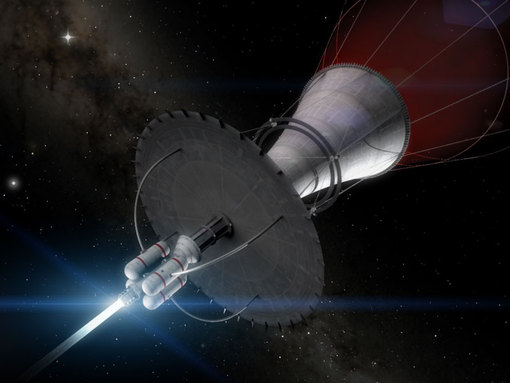
As the machine gains speed, reaction mass falls in the limiting magnetic field that compresses it prior to fusion. The magnetic field then directs the energy in the rocket nozzle, accelerating the ship. Because no fuel tanks will not slow down, a fusion RAMJET can reach speeds of about 4% of light and go anywhere in the galaxy.
However in this mission there are lots of possible disadvantages. For example, the problem of friction. The spacecraft relies on a high rate of collection of fuel, but will be faced with a large number of interstellar hydrogen and lose the speed — especially in dense regions of the galaxy. Secondly, deuterium and tritium (which are used in reactors on Earth) in space a bit, and the synthesis of ordinary hydrogen, which is a lot of space, while we can’t control.
However, science fiction has loved the concept. The most famous example is, perhaps, the franchise “Star trek” where used “collectors of Bussard”. In reality, our understanding of the synthesis reactor is not as perfect as we would like.
Laser sail
Solar sails have long considered an effective way of conquering the Solar system. Besides the fact that they are relatively simple and cheap to manufacture, they have a big plus: they don’t need fuel. Instead of using rockets that need fuel, the sail uses the radiation pressure of the stars to disperse ultra-thin mirrors to high speeds.
However, in the case of interstellar flight, the sail will have to push focused energy beams (laser or microwave) to accelerate to speeds close to that of light. The concept was first proposed by Robert Forward in 1984, physicist laboratory Hughes Aircraft.
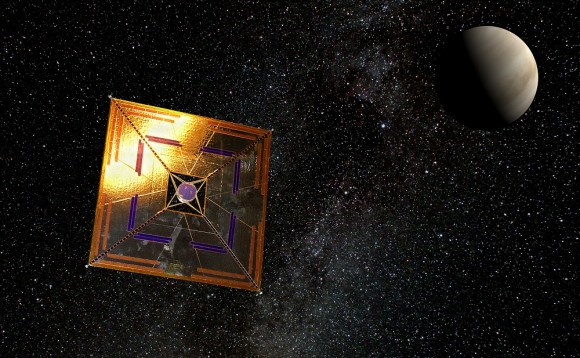
His idea has all the advantages of a solar sail that requires no fuel on Board, as well as in the fact that laser energy is not dissipated in the distance as the solar radiation. Thus, although the laser sail will take some time to accelerate to relativistic speeds, it will then be limited only by the speed of the light itself.
According to the research of Robert Frisbee in 2000, Director of research of advanced propulsion concepts at the jet propulsion Laboratory of NASA, laser sail acceleration to half light speed in less than ten years. He also calculated that a sail with a diameter of 320 kilometers could reach Proxima Centauri in 12 years. Meanwhile, sail 965 kilometers in diameter will arrive in just 9 years.
However, to build such a sail have from advanced composite materials to avoid melting. That will be especially difficult, given the size of the sails. Even worse is the case with costs. According to Frisbee, the lasers will need a steady stream of 17 000 terawatts of energy — about as much the entire world consumes in one day.
The engine on the antimatter
Science fiction fans know what antimatter. But if you forget, antimatter is a substance consisting of particles that have the same mass as ordinary particles, but opposite charge. The antimatter engine is a hypothetical engine, which is based on the interaction between matter and antimatter to generate power or produce thrust.
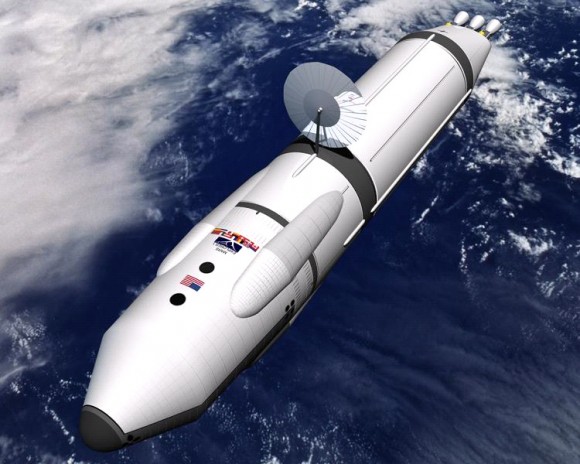
In short, the engine uses antimatter colliding with each other particles of hydrogen and antihydrogen. Emitted in the annihilation process energy is comparable in volume with the energy of explosion of a thermonuclear bomb accompanied by a flow of subatomic particles — pions and muons. These particles, which move at a speed one-third of the speed of light is diverted in a magnetic nozzle and produce thrust.
The advantage of this class of missiles that most of the weight of the mixture of matter/antimatter can be converted into energy that ensures high energy density and specific impulse, superior to any other rocket. Moreover, the annihilation reaction can accelerate the craft to half the speed of light.
This class of rockets will be the fastest and most energy efficient possible (or impossible, but suggested). If conventional chemical rockets require tons of fuel to move the spacecraft to its destination, the engine on the antimatter will do the same job at the expense of a few milligrams of fuel. Mutual destruction pound of particles of hydrogen and antihydrogen releases more energy than a 10-megaton hydrogen bomb.
For this reason, the Institute for advanced concepts NASA is exploring this technology as possible for future missions to Mars. Unfortunately, if we consider missions to nearby star systems, the amount of fuel required grows exponentially, and the costs become astronomical (and no pun intended).

According to the report, prepared for the 39th conference AIAA/ASME/SAE/ASEE Joint Propulsion Conference and Exhibit, two-stage rocket on the antimatter will require more than 815 000 metric tons of fuel to get to Proxima Centauri in 40 years. It is relatively fast. But the price…
Although one gram of antimatter produces an incredible amount of energy, the production of only one gram would require 25 million billion kilowatt-hours of energy and will result in a trillion dollars. At present, the total amount of antimatter, which was created by people, is less than 20 nanogrammov.
And even if we could cheaply produce antimatter, we would need a massive ship that could hold the required amount of fuel. According to the report, Dr. Darrell Smith and Jonathan ironic gestures aside from the Aviation University, Embry-riddle in Arizona, the starship with the engine on the antimatter could gain speed in 0.5 and light to reach Proxima Centauri in a little over 8 years. However, the ship itself would weigh 400 tons, and would require 170 tons of fuel from antimatter.
A possible way around this is to create a ship that can create antimatter with its subsequent use as fuel. This concept, known as Vacuum to Antimatter Rocket Interstellar Explorer System (VARIES), was proposed by Richard Obousy from Icarus Interstellar. Based on the idea of recycling in place, the ship VARIES must use large lasers (powered by huge solar panels), creating particles of antimatter when fired at empty space.

Like the concept with the fusion RAMJET, the proposal solves the problem of carrying fuel at the expense of its extraction from the space. But again, the cost of this vehicle will be extremely high, if you build it by our modern methods. We are not able to create antimatter in huge scale. And still need to solve the problem with the radiation, because the annihilation of matter and antimatter produces flashes of high-energy gamma rays.
They not only pose a danger to the crew, but also for the engine to keep them from falling apart on the subatomic particles under the influence of this radiation. In short, the engine on the antimatter completely impractical given our modern technology.
Warp drive Alcubierre
Science fiction fans no doubt are familiar with the concept of a warp (or Alcubierre engine). Proposed by Mexican physicist Miguel Alcubierre in 1994, this idea was an attempt to imagine an instant movement in space without violating the special theory of relativity. Briefly, this concept involves stretching the fabric of space-time in a wave, which theoretically will lead to the fact that the space in front of the object will be compressed, and behind it — to expand.
The object within this wave (our ship) will be able to go on this wave, being in the “warp bubble” at a speed much higher than the relativistic. Since the ship is not moving in the bladder, and is transferred to them, the laws of relativity and space-time will not be violated. In fact, this method does not involve movement faster than the speed of light in a local sense.
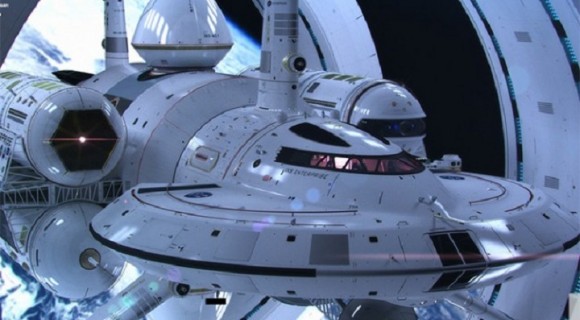
“Faster than light” it is only in the sense that the ship can reach the destination quicker than a ray of light travelling outside the warp bubble. If we assume that the spacecraft will be equipped with a system of Alcubierre, it will reach Proxima Centauri in less than 4 years. Therefore, if we talk about theoretical interstellar space travel, this is definitely the most promising technology in terms of speed.
Of course, this whole concept is extremely controversial. Among the arguments against, for example, that it does not take into account quantum mechanics and can be refuted by the theory of everything (like loop quantum gravity). Calculations of the necessary amount of energy also showed that the warp engine will be excessively voracious. Other uncertainties include the safety of such systems, the effects of space-time at the destination and violations of causality.
However, in 2012, NASA scientist Harold white stated that together with his colleagues began to explore the possibility of an Alcubierre engine. White said that they built an interferometer that will detect the spatial distortions produced by the expansion and contraction of the spacetime of the Alcubierre metric.
In 2013, the jet propulsion Laboratory published the results of tests of the warp fields that were carried out in vacuum conditions. Unfortunately, the results were deemed “inconclusive”. In the long run we may find that the Alcubierre metric violates one or more fundamental laws of nature. And even if his physics is correct, there is no guarantee that the Alcubierre system can be used for flying.
In General, all as usual: you were born too early to travel to the nearest star. However, if mankind feel the need to build an “interstellar ark”, which will accommodate a self-sustaining human society, to get to Proxima Centauri will be able for a hundred years. If we will certainly want to invest in such an event.
As for time, all available methods seem to be very limited. And if you spend hundreds of thousands of years to travel to the nearest star may be of little interest to us, when our own survival is at stake, as the development of space technologies and methods will be extremely impractical. By the time our ark will reach the nearest star, its technology will become obsolete, and humanity itself may not exist.
So if we don’t implement a major breakthrough in the field of fusion, antimatter, or laser technology, we will be content to study our own Solar system.
According to the materials of Universe Today
